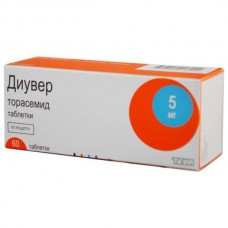Expiration date: 12/2027
Active substance: Torasemide
The drug forms
Tablets 5 mg: white or almost white round biconvex with beveled, Valium on one side and engraved "915" on the other side.
Tablets 10 mg: white or almost white round biconvex with beveled, Valium on one side and engraved "916" on the other side.
Pharmachologic effect
Mode of action - a diuretic.
Pharmacodynamics
Torasemide is a loop diuretic. The maximum diuretic effect develops after 2-3 hours after ingestion of the drug. The main mechanism of action of the drug due to the reversible binding of torasemide kontransporterom sodium / chlorine / potassium ions located in the apical membrane of the thick ascending part of Henle segment loop, resulting in reduced or completely inhibited by sodium ion reabsorption and decreases the osmotic pressure of the intracellular fluid and water reabsorption. Blocks myocardial aldosterone receptors, reduces fibrosis and improves diastolic myocardial function.
Torasemide less than furosemide causes hypokalemia, while it is more active, and more lasting effect.
The use of torasemide is the most reasonable choice for long-term therapy.
Pharmacokinetics
After oral torasemide is rapidly and almost completely absorbed in the digestive tract. Torasemide Cmax in plasma observed after 1-2 hours after ingestion after eating. Bioavailability is 80-90% with slight individual variations.
The diuretic effect persists for up to 18 hours to facilitate the portability of therapy due to lack of very frequent urination during the first hours after ingestion of the drug, which limits patient activity.
Communication to plasma proteins up to 99%. Visible Vd is 16 liters.
It is metabolized in the liver via the cytochrome P450 isoenzyme system. As a result, sequential reactions of oxidation and hydroxylation are formed three annular hydroxylation metabolite (M1, M3 and M5) that bind to plasma proteins at 86, 95 and 97%, respectively.
T1 / 2 of torasemide and its metabolites is 3-4 hours, and does not change with CRF. Torasemide total clearance of 40 ml / min, renal clearance - 10 ml / min. On average, about 83% of the dose excreted by the kidneys: in unchanged form (24%) and mainly in the form of active metabolites (the M1 - 12%, M3 - 3%, M5 - 41%).
In renal insufficiency, T1 / 2 is not changed, T1 / 2 and M5 metabolites MH increases. Torasemide and its metabolites are excreted in slightly by hemodialysis and hemofiltration.
In liver failure plasma concentration increases due to the reduction of torasemide drug metabolism in the liver. In patients with cardiac or hepatic insufficiency T1 / 2 of torasemide and metabolite M5 significantly increased accumulation of the drug is unlikely.
Testimony
- edematous syndrome of various genesis, including in chronic heart failure, diseases of the liver, lungs and kidneys;
- arterial hypertension.
Contraindications
- Hypersensitivity to torasemide or any of the components;
- allergic to sulfonamides (sulfa antimicrobials or sulfonylureas);
- renal failure with anuria;
- hepatic coma and precoma;
- severe hypokalemia;
- severe hyponatremia;
- hypovolemia (hypotension with or without), or dehydration;
- pronounced violations of the outflow of urine from any cause (including unilateral urinary tract disease);
- glycoside intoxication;
- acute glomerulonephritis;
- decompensated aortic and mitral stenosis, hypertrophic obstructive cardiomyopathy;
- elevated central venous pressure (more than 10 mm Hg..);
- hyperuricemia;
- lactose intolerance, lactase deficiency or glucose-galactose malabsorption;
- lactation;
- age 18 years.
With caution: arterial hypotension; constrictive atherosclerosis of cerebral arteries; hypoproteinemia; predisposed to hyperuricemia; violation of the outflow of urine (benign prostatic hyperplasia, narrowing of the urethra or hydronephrosis); ventricular arrhythmia in history; acute myocardial infarction (increased risk of cardiogenic shock); diarrhea; pancreatitis; diabetes mellitus (impaired glucose tolerance); hepatorenal syndrome; gout; anemia; pregnancy.
Pregnancy and breast-feeding
Torasemide is not teratogenic and fetotoxic, crosses the placental barrier, causing a violation of water-electrolyte metabolism and thrombocytopenia in the fetus.
Diuver drug during pregnancy can be used only when the benefit to the mother outweighs the potential risk to the fetus, only under medical supervision and only in minimal doses.
It is not known whether torasemide passes into breast milk. If necessary, use Diuver during lactation should stop breastfeeding.
Side effects
From the water-electrolyte and acid-base balance: hyponatremia, hyposalemia, hypokalemia, hypomagnesemia, hypocalcemia, metabolic alkalosis. Symptoms indicating the development of disorders of electrolyte and acid-base balance state can be a headache, confusion, cramps, tetany, muscle weakness, heart rhythm disturbances and dyspepsia; hypovolemia and dehydration (often in elderly patients), which may cause hemoconcentration with a tendency to develop thrombosis.
From the CCC: an excessive fall in blood pressure, orthostatic hypotension, collapse, tachycardia, arrhythmias, decreased CBV.
From a metabolism: hypercholesterolemia, hypertriglyceridemia; transient increase in the concentration of urea and creatinine in the blood; increased concentration of uric acid in the blood, which may cause or exacerbate symptoms of gout; impaired glucose tolerance (can be a manifestation of latent diabetes mellitus flowing).
From the urinary system: oliguria, acute urinary retention (such as prostatic hyperplasia, narrowing of the urethra, hydronephrosis); interstitial nephritis, hematuria, reduced potency.
On the part of the digestive tract: nausea, vomiting, diarrhea, intrahepatic cholestasis, elevated liver enzymes, acute pancreatitis.
On the part of the central nervous system, organ of hearing: hearing loss, usually reversible, and / or ringing in the ears, especially in patients with renal failure or hypoproteinemia (nephrotic syndrome), paresthesia.
For the skin: itching, urticaria, other rashes or bullous skin lesions, erythema multiforme, exfoliative dermatitis, purpura, fever, vasculitis, eosinophilia, photosensitivity; severe anaphylactic or anaphylactoid reactions up to shock, which have hitherto been described only after the on / in the introduction.
From the peripheral blood: thrombocytopenia, leukopenia, agranulocytosis, aplastic or hemolytic anemia.
Interaction
It improves concentration and the risk of nephrotoxicity and ototoxicity action of cephalosporins, aminoglycosides, chloramphenicol, ethacrynic acid, cisplatin, amphotericin B (as a result of competitive renal excretion). It improves the effectiveness of diazoxide and theophylline reduces - hypoglycemic agents, allopurinol.
Pressor amines and torasemide mutually reduce efficiency.
Drugs that block tubular secretion, increase the concentration in the blood serum of torasemide.
With simultaneous use of corticosteroids, amphotericin B increases the risk of hypokalemia, with cardiac glycosides - increase the risk of glycoside intoxication as a result of hypokalemia (for high and low polarity) and elongation T1 / 2 (for low polarity).
Decreases renal clearance of lithium and drugs increases the risk of intoxication.
NSAIDs, sucralfate reduces the diuretic effect by inhibiting the synthesis of PG, violations of renin activity in plasma and excretion of aldosterone. It enhances the hypotensive effect of antihypertensive drugs, neuromuscular blockade depolarizing muscle relaxants (suxamethonium), and reduces the effect of non-depolarizing muscle relaxants (tubocurarine).
Simultaneous administration of large doses of salicylates on the background of torasemide therapy increases the risk of symptoms of toxicity (because of competitive renal excretion).
Sequential or simultaneous use of torasemide with ACE inhibitors or angiotensin II receptor antagonists may result in a strong reduction in blood pressure. This can be avoided by reducing the dose of torasemide or temporarily cancel it. Simultaneous use of probenecid or methotrexate may reduce the effectiveness of torasemide (same secretory pathway). On the other hand, torasemide may reduce renal elimination of these drugs.
With simultaneous application of cyclosporine and torasemide increased risk of gouty arthritis due to the fact that cyclosporine may cause a violation of urate excretion by the kidneys, and torasemide - hyperuricemia. It has been reported that patients with a high risk of developing nephropathy, taking torasemide inside, with the introduction of radiopaque agents impaired renal function were observed more frequently than in patients with high risk of developing nephropathy, which before the introduction of contrast media were performed intravenous hydration.
Dosing and Administration
Inside, once a day, after breakfast, washed down with a little water.
Edematous syndrome of various genesis, including in CHF, liver, lungs and kidneys
The usual therapeutic dose is 5 mg orally once daily. If necessary, the dose should be gradually increased up to 20-40 mg once a day, in some cases - to 200 mg per day. The drug is prescribed for a long period or until disappearance of edema.
Arterial hypertension
The starting dose is 2.5 mg (Table 2.1. 5 mg) once a day. If necessary, the dose may be increased up to 5 mg once a day.
Elderly patients Dose adjustment is not required.
Overdose
Symptoms: excessive urine output increased, accompanied by a decrease in the bcc and disturbance of electrolytic balance of blood, followed by a pronounced decrease in blood pressure, drowsiness and confusion, collapse. gastrointestinal disturbances may occur.
Treatment: No specific antidote. The provocation of vomiting, gastric lavage, activated charcoal. Treatment is symptomatic, a dose reduction or withdrawal of the drug and the simultaneous volume replacement and correction of indicators of water and electrolyte balance and acid-base status under the control of serum electrolyte concentrations, hematocrit. Hemodialysis is ineffective.
Special instructions
Apply strictly on prescription.
Patients with hypersensitivity to sulfonamides and sulfonylureas may have a cross sensitivity to Diuver drug.
Patients receiving high doses Diuver the drug over a long period, to avoid the development of hyponatremia, hypokalemia and metabolic alkalosis, it is recommended diet with enough salt and potassium use of drugs.
Increased risk of violations of water-electrolyte balance observed in patients with renal insufficiency. During the course of treatment is necessary to periodically monitor the concentration of electrolytes in blood plasma (including sodium, calcium, potassium, magnesium), acid-base status, residual nitrogen, creatinine, uric acid, and carry out the appropriate corrective therapy if necessary (with more magnification in patients with frequent vomiting and background parenterally administrable fluids).
When new or worsening azotemia and oliguria in patients with severe progressive renal disease is recommended to suspend the treatment.
Selection mode doses to patients with ascites on the background of cirrhosis of the liver should be carried out under steady-state conditions (violation of water and electrolyte balance may lead to the development of hepatic coma). This category of patients shows regular monitoring of plasma electrolytes.
In patients with diabetes or impaired glucose tolerance requires periodic monitoring of glucose levels in blood and urine.
In patients in an unconscious state, with hyperplasia of the prostate, narrowing of the ureter is necessary to monitor urine output due to the possibility of acute urinary retention.
During treatment, patients should refrain from driving and other activities potentially hazardous activities that require high concentration and psychomotor speed reactions.
Release Form
Tablets 5 mg, 10 mg. According to Table 10. a blister film PVC / PVDC and aluminum foil. 2 or 6 blister pack in a cardboard.
Storage conditions
The temperature is not above 30 ° C.
Keep out of the reach of children.
The shelf life
3 years.
Do not use beyond the expiration date printed on the package.






